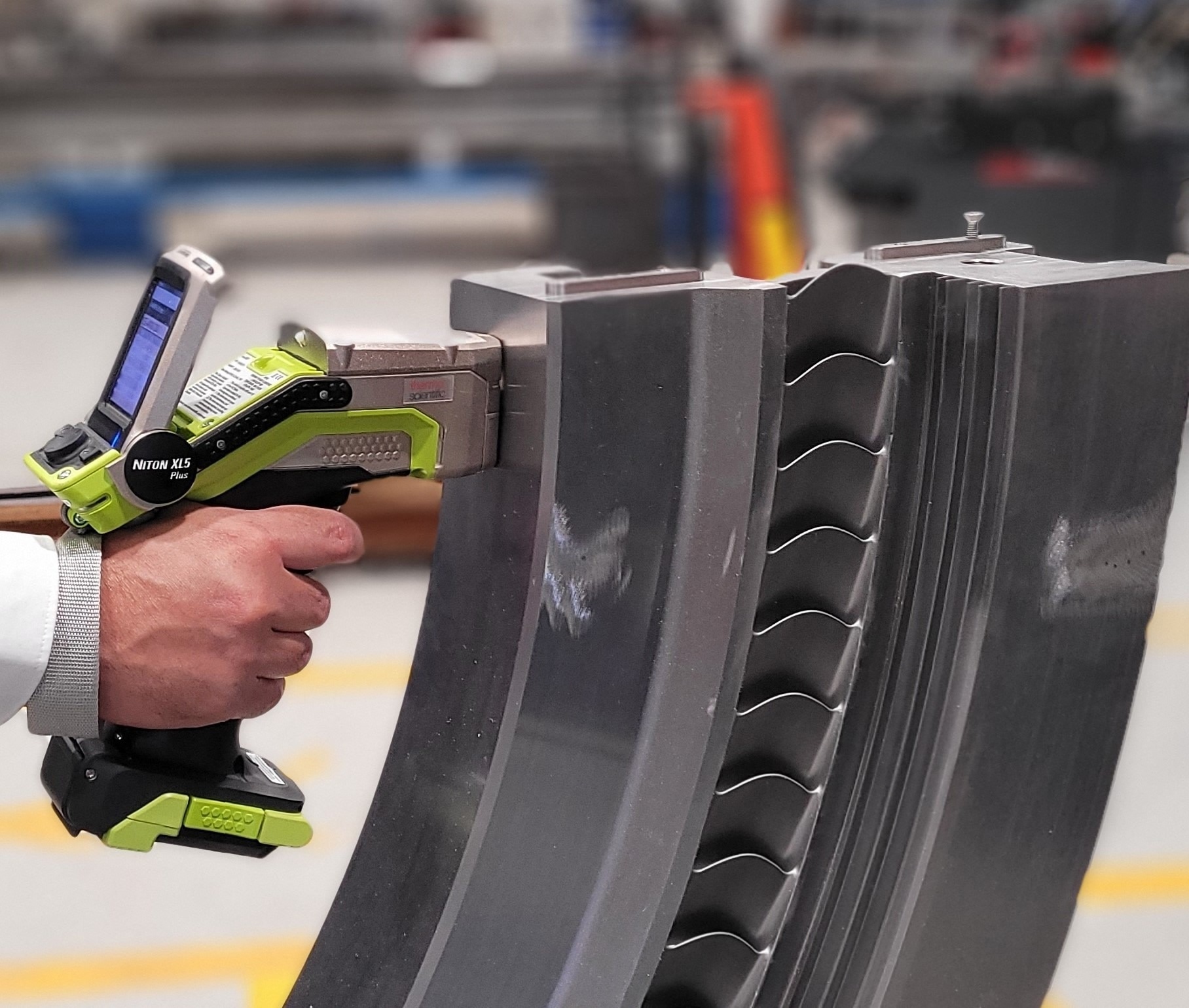The potential for material mix-ups in manufacturing and metal fabrication is very real, with movement from metal production to service centers and distributors and component fabrication to final product assembly. That makes traceability a priority, along with reliable material verification for QA/QC.
Nondestructive handheld XRF analysis allows manufacturers and fabricators to rapidly analyze metal alloys, recover lost material traceability, verify the specification of finished products, and more.
Why is quality control of metals and alloys important?
Analyzing metals and ensuring the correct alloy is being used is key to preventing dangerous failures. This is especially important in mission-critical alloys, such as those used in aerospace, construction, or power generation.
Performing quality control on metals in these and other industries also helps prevent profit loss, product recalls, and rework. Additionally, the quality of metals and alloys is crucial for compliance with regulations and industry standards.
Ensuring quality and performance for metal alloys helps preserve a company's reputation and prevent negative customer perceptions. An additional benefit of systematically performing quality control on incoming goods is that it increases the accountability of raw material suppliers.
What technologies can be used for bulk analysis quality control?
Multiple technologies are available for bulk analysis of metals and alloys. These include lab methods such as inductively coupled plasma optical emission spectroscopy mass spectrometry (ICP-OES/MS), atomic absorption spectrometry (AAS), energy dispersive or wavelength dispersive X-ray fluorescence spectrometry (ED/WD-XRF), or stationary optical emission spectrometry (OES).
Lab technologies deliver the best analytical performance but are not always convenient. Samples still need to be taken and transported to the lab, which results in relatively low sample throughput.
In addition, the lab technologies often involve destructive processes. For example, ICP and AAS require dissolving the sample, while XRF and OES usually involve cutting the sample and placing it in the testing chamber. Moreover, operating these techniques demands a certain level of expertise from the people running the analyses.
In contrast, mobile and handheld technologies like OES, laser-induced breakdown spectroscopy (LIBS), and handheld XRF provide rapid results with good precision. Notably, handheld XRF is fully nondestructive and very user-friendly.
How does handheld XRF work?

Image credit: Thermo Fisher Scientific
XRF stands for X-ray fluorescence spectrometry. A miniaturized tube irradiates the surface of the sample, causing the atoms on the surface to absorb this radiation. During this process, an electron close to the nucleus is ejected. An electron from an upper shell fills the vacancy, and in this process, a secondary X-ray photon specific to every element is emitted.
This photon creates pulses of a value proportional to its energy in the semiconductor detector crystal. These pulses and their frequencies are counted, resulting in a spectrum. The spectrum is then processed by an algorithm that calculates and displays the chemical composition on the screen in real time.
Modern handheld XRF devices can detect different elements depending on the detector technology. For example, those with a silicon drift detector (SDD) can detect elements from magnesium to uranium, while those with a silicon PIN diode can detect elements from chlorine to uranium.
XRF is a method of elemental analysis that provides information about the presence of one or several elements and their total concentration, regardless of the oxidation state of the elements in the sample. Typically, one to four X-ray lines are detectable for each element.
The spectrum is like the material's fingerprint, with the X-axis representing the energy of the detected photons. Since these energies are element-specific, they provide information for qualitative analysis, indicating which elements are present in the sample.
What are the advantages of handheld XRF for bulk QC analysis?
Handheld XRF analyzers are delivered pre-calibrated and can generally be operated in a point-and-shoot mode out of the box. Depending on the detector technology, they can detect elements ranging from magnesium to uranium.
The spot size of handheld XRF is typically around eight millimeters in diameter, which is about one-third of an inch, and there is also the option to focus on smaller areas of three millimeters, approximately one-tenth of an inch.
A significant advantage of handheld XRF is that it is fully nondestructive and generates near laboratory-grade results. Additionally, very little to no sample preparation is required to analyze solid metals. Handheld XRF is also highly tolerant of irregular-shaped metal samples, thanks to a normalization process that sums the measured concentrations to 100%. Moreover, it is very easy to operate and maintain.
Can you describe the features of analytical methods used in handheld XRF for metal analysis?
The analytical methods used to analyze solid or bulk metals assume that the sample is homogeneous, and the output will be a chemical composition expressed in units such as weight percent or parts per million (ppm). Handheld XRF analyzers are generally pre-calibrated with fit-for-purpose applications that work out of the box without the need for user calibration or setup, especially for metal analysis.
The calibration method, the fundamental parameter method, utilizes physical constants to model the interactions between elements. Unlike empirical calibration methods, which rely on a set of calibration samples, the fundamental parameter method is highly robust to variations in matrix composition. It performs effectively with exotic materials or compositions that differ significantly from standard reference materials.
The identification of an alloy grade is usually completed within two seconds. For light elements, longer measurement times—typically up to 10 seconds—are often necessary. Additionally, detecting trace amounts of heavy metals in the 100 ppm range or lower generally requires an extended testing duration of up to a minute or two.
What kind of metal and alloys used in manufacturing and metal fabrication can be identified with a handheld XRF analyzer?
To identify metals and alloys, handheld XRF analyzers compare the measured composition with the library of tabulated composition limits for common grades of metals and alloys used in the industry. The analyzer displays the alloy grade that matches the measured composition closest. The standard library comprises about 500 grades of all metal bases, including pure metals, low-alloy steels, tool steels, stainless steels, and alloys of nickel, cobalt, copper, titanium, aluminum, and magnesium, as well as exotic metals and alloys.
The standard library uses US standards such as ASTM and AISI and standards from organizations like the Aluminum Association and Copper Development Association. The libraries have also been translated into other standards, such as German DIN and Chinese GB standards. The user can augment the library or even fully customize it from scratch.
How accurate is handheld XRF for metal analysis?
Handheld XRF analyzers have been shown to achieve excellent accuracy. The accuracy generally depends on the concentration level of a given element in each alloy. At high concentrations, the accuracy is usually better than a few percents relative deviation to the true value, which is equivalent to a few tenths of a percent in terms of absolute concentration. When concentrations decrease, the accuracy tends to decrease in terms of relative deviation.
Analyzing certified reference materials, the correlation between the certified values and measured values is generally very high, with an R2 value exceeding 0.99This strong correlation indicates that the algorithm and calibration effectively correct for matrix effects. The linear regression slope being close to one demonstrates that the systematic error, or bias, is minimal.
When analyzing real-life samples, the user should ensure that the sample's surface is free of contamination and heavy corrosion. Light corrosion will barely affect the measurement accuracy for heavy elements from titanium to bismuth but will impact measurement accuracy for light elements such as magnesium, aluminum, and silicon. Corrosion and contamination can be removed by grinding the surface and cleaning the measurement spot using a solvent. Overall, handheld XRF technology delivers lab-quality results for metal and alloy analysis.
What solutions does Thermo Fisher Scientific offer for handheld XRF analysis in QC of metals and alloys?
Thermo Fisher offers a full range of analyzers designed to meet various user needs across a wide range of applications, including metal manufacturing and fabrication, positive material identification (PMI) in industries such as oil and gas or power generation, scrap metal recycling, and precious metal analysis for gold, silver, and other highly valued metals.
Thermo Scientific™ Niton™ Handheld XRF Analyzers can also be used for non-metal analysis, such as geochemical analysis in mining, soil analysis for environmental applications, catalytic converter recycling, and screening consumer goods for heavy metals.
The Niton XL2 100G analyzer is the value model known for its simplicity, readiness, and affordability. It delivers excellent accuracy for alloy identification in various metals and alloys, including aluminum grades, provided the identification does not rely on light elements.
The Niton XL2 Plus analyzer uses a different silicon drift detector technology that enables the detection of light element such as aluminum, silicon, phosphorus, sulfur, and magnesium. This means the analyzer can distinguish between grades that differ based on light element content, such as differentiating stainless steel 304 from 303 or aluminum alloy 3003 from 3004.
The Niton XL5 Plus analyzer is the premium solution, being the smallest, lightest, and most powerful Niton XRF analyzer available.
It delivers best-in-class performance, making it ideal for faster measurements and advanced applications such as measuring low levels of impurities, residual, or tramp elements in metals. The Niton XL5 Plus analyzer also enables users to measure the thickness of up to four layers of metal coatings.
How does handheld XRF technology enable faster decision-making in metalworking and manufacturing industries?
In environments where most metals appear similar, handheld XRF analyzers are invaluable for machining workshops and industries that manufacture or use metals. The analyzers are essential tools for inspecting incoming materials to ensure the quality of purchased components and verify that manufactured goods meet material specifications. Handheld XRF helps prevent material mix-ups and recover traceability when labels are incorrect, difficult to read, or lost.
The technology offers nondestructive, real-time, and near-line measurements in various settings, making it highly practical and cost-effective. In addition, it requires minimal maintenance, and no consumables are needed to analyze metals and alloys. Handheld XRF analyzers are user-friendly, even for non-experts, and they enhance productivity by enabling faster, more confident decision-making onsite.
About Mathieu Bauer 
Mathieu Bauer holds a PhD in analytical chemistry from the University of Hamburg and has over 20 years of experience working with spectroscopy, including handheld X-ray fluorescence (HHXRF).
Mathieu is currently working as a senior application scientist and associate product manager at Thermo Fisher Scientific.

This information has been sourced, reviewed and adapted from materials provided by Thermo Fisher Scientific – Handheld Elemental & Radiation Detection.
For more information on this source, please visit Thermo Fisher Scientific – Handheld Elemental & Radiation Detection.
Disclaimer: The views expressed here are those of the interviewee and do not necessarily represent the views of AZoM.com Limited (T/A) AZoNetwork, the owner and operator of this website. This disclaimer forms part of the Terms and Conditions of use of this website.